 Pirates and Privateers Pirates and Privateers
The History of Maritime
Piracy
Cindy Vallar, Editor
& Reviewer
P.O. Box 425,
Keller, TX 76244-0425
    
Oh To Be a
Pirate
by Cindy Vallar
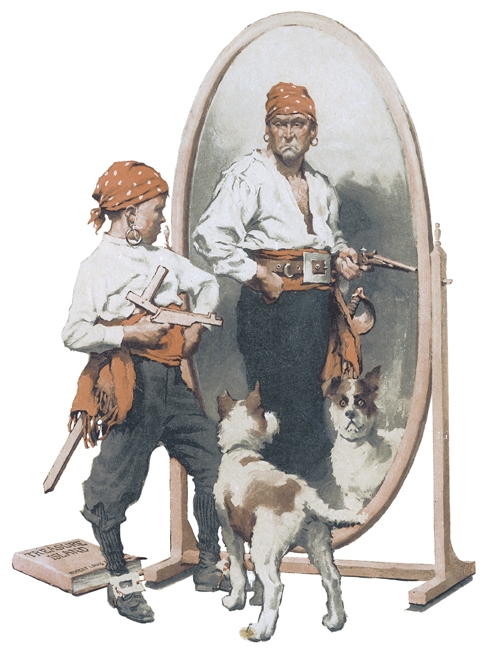
Life
aboard a sailing ship was anything but comfortable.
Seamen lived in cramped and filthy quarters. Rats
gnawed through anything, including a ship’s hull.
Food spoiled or became infested, and fresh water
turned foul. One staple of most ships was hard tack,
which seaman often ate in the dark to avoid seeing
the weevils that infested the square biscuits. To
soften hardtack
and make it more palatable, cooks might soak and
boil them in rum and brown sugar to create a
porridge-like mixture.
Pirates restocked their food supplies by stealing
from other ships’ stores. In the Caribbean, they
also caught turtle
for fresh meat. Sea turtles were easily snared
on land and were kept alive in the ship’s hold until
needed. Their soft-shelled eggs were a popular
delicacy. Pirates’ recountings of their adventures
also mention fishing for dolphins, albacore tuna,
and other varieties of fish. One popular dish
was salmagundi
or Solomon Grundy. Similar to a chef salad, it
contained marinated bits of fish, turtle, and meat
combined with herbs, palm hearts, spiced wine, and
oil. This concoction was then served with
hard-boiled eggs, pickled onions, cabbage, grapes,
and olives. Pirates also ate yams, plantains,
pineapples, papayas, and other fruits and vegetables
indigenous to the tropics.
They drank bombo or bumboo, a mixture of rum, water,
sugar, and nutmeg. Rumfustian was another popular drink
that blended raw eggs with sugar, sherry, gin, and
beer. Pirates also enjoyed beer, sherry, brandy, and
port.
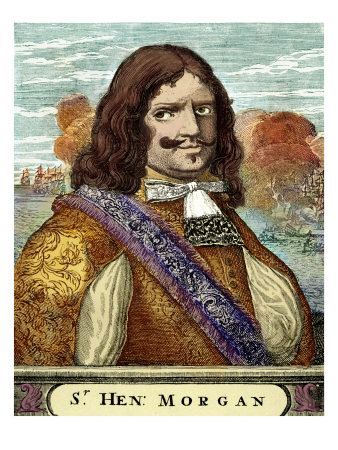 When
food was scarce, they resorted to more desperate
measures to stay alive. Charlotte de Berry’s crew
ran out of food and purportedly ate two slaves and
her husband to sustain them. In 1670, Sir Henry
Morgan’s crew ate their leather satchels. They
recommended cutting the leather into strips. After
soaking these, they tenderized them by beating and
rubbing the leather with stones. They scraped off
the hair, and then roasted or grilled the strips
before cutting them into bite-size pieces. The
recipe suggested serving them with a lot of water. When
food was scarce, they resorted to more desperate
measures to stay alive. Charlotte de Berry’s crew
ran out of food and purportedly ate two slaves and
her husband to sustain them. In 1670, Sir Henry
Morgan’s crew ate their leather satchels. They
recommended cutting the leather into strips. After
soaking these, they tenderized them by beating and
rubbing the leather with stones. They scraped off
the hair, and then roasted or grilled the strips
before cutting them into bite-size pieces. The
recipe suggested serving them with a lot of water.
Among artifacts
uncovered in shipwrecks, pirate havens, and other
areas frequented by pirates, archeologists have
found glass wine and brandy bottles, earthenware
beer bottles, pewter plates and tankards, and
silverware, especially knives and spoons.
Forks were a symbol of wealth and the few found may
have been part of pirate treasure. Pirates,
however, preferred to eat with their fingers.
Some pirate ships had galleys and some, like Captain
Kidd’s Adventure Galley, had none.
Instead, food was cooked in a cauldron with a brick
hearth that operated only during periods of calm
weather. It was located far from the magazine
to prevent accidental igniting of the gunpowder.
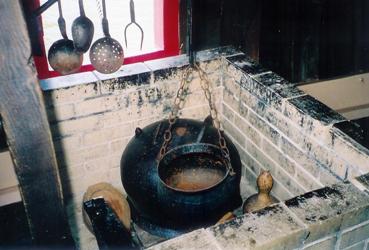 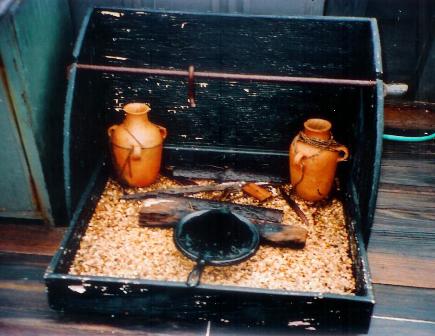
Left: Galley stove aboard Elizabeth
II in 1585 to Roanoke Island, an expedition
backed by Sir Walter Raleigh
Right: Portable galley as used aboard
Columbus's ships in 1492
(Source: Author)
Between the excitement of sighting sail and
weathering dangerous storms, pirates followed the
same dull routine that numbed seamen’s minds. Much
of their time was occupied with the care and
maintenance of their ships. They patched sails using
pickers (used to make small holes in canvas), seam
rubbers, needles, and sailmaker’s
palms (provided protection for the hand). They
spliced ropes with a fid. To keep the ship
watertight, they hacked old oakum from seams using a
jerry iron, drove new oakum
into the seams with a caulking iron, and then ladled
hot pitch into the seams to seal them tight.
Sometimes they sought the shelter of hidden coves to
careen their ships to remove the worms that bored
tiny holes in the hull, producing leaks, and to
scrape off barnacles that slowed the ship.
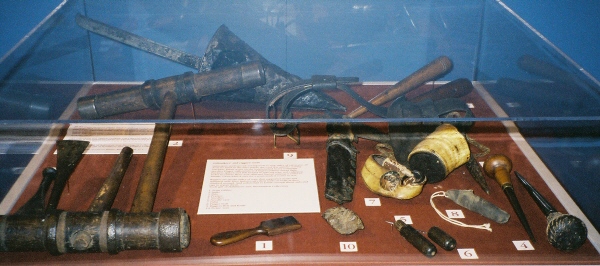 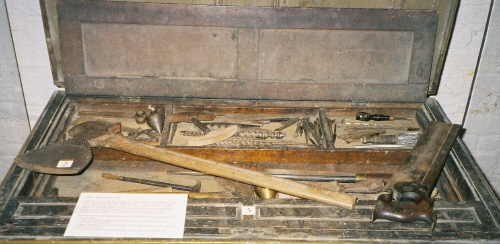
Tools used by ship's sailmaker
and rigger (left) and carpenter (right)
(Source: Author)
Pirates relaxed like other seamen. They played cards
or rolled dice, although most articles of agreement
forbade gambling on board ships to prevent arguments
that divided the crew or proved fatal to one or more
participants. At sea, they chewed tobacco rather
than smoked because of the ever-present threat of
fire, a serious fear aboard wooden ships. They
carved, sang, and danced jigs. When ashore, pirates
squandered their booty on drink, women, and games of
chance. They smoked clay pipes. Tavern keepers
served them beer and wine in black jacks, leather
tankards coated with pitch, or pewter tankards.
One popular pastime amongst pirates was the mock
trial. Each man played a part be it jailer, lawyer,
judge, juror, or hangman. This sham court arrested,
tried, convicted, and “carried out” the sentence to
the amusement of all.
No matter where they sailed, pirates frequented
friendly ports. One of the most infamous was Port Royal.
God-fearing people thought it the most wicked of
cities and believed that the earthquake
that brought about its destruction in 1692 was
payment for its sinfulness and debauchery. Tortuga
and Madagascar
also welcomed pirates.
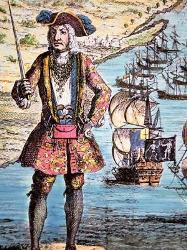 Ashore, some pirates
emulated gentleman merchants by wearing knee
breeches, stockings, embroidered waistcoats,
lace-trimmed shirts, long coats, and shoes with
silver buckles and high heels. A few wore powdered
wigs or ornate jewelry. They acquired these brightly
colored garments as shares of booty taken from
captured ships. Some pirates dressed like gentlemen
when facing their own executions by hanging: velvet
jackets, taffeta breeches, silk shirts and hose, and
felt tricornes. One of the best dressed pirates was
Bartholomew
Roberts, who dressed in a rich crimson damask
waistcoat and breeches, a red feather in his hat, a
gold chain round his neck, with a diamond cross
hanging to it. Ashore, some pirates
emulated gentleman merchants by wearing knee
breeches, stockings, embroidered waistcoats,
lace-trimmed shirts, long coats, and shoes with
silver buckles and high heels. A few wore powdered
wigs or ornate jewelry. They acquired these brightly
colored garments as shares of booty taken from
captured ships. Some pirates dressed like gentlemen
when facing their own executions by hanging: velvet
jackets, taffeta breeches, silk shirts and hose, and
felt tricornes. One of the best dressed pirates was
Bartholomew
Roberts, who dressed in a rich crimson damask
waistcoat and breeches, a red feather in his hat, a
gold chain round his neck, with a diamond cross
hanging to it.
While at sea, they usually wore one outfit until the
garments were no better than rags. Seamen favored
fearnoughts (short jackets of heavy blue or gray
cloth) or canvas coats (in foul weather), red or
blue waistcoats, plain or checked shirts (often blue
and white), and petticoat breeches (canvas trousers
cut a few inches above one’s ankles). These were
often coated with tar to make them waterproof and to
deflect sword thrusts. Shoes were worn on shore, but
rarely aboard a ship. To protect themselves from the
hot sun, they wore knotted scarves, tricorn hats, or
various styles of caps. The Ilanun of
Borneo, the most feared pirates in the waters
around Southeast Asia during the mid-1800s, wore
sarongs and embroidered belts.
Most men who chose to go to sea did so at a young
age. Life at sea required stamina and dexterity that
older men no longer possessed. Seamen hauled on wet
ropes during the day and at night. Aloft, they
handled heavy sails in calm or stormy weather. They
manned pumps for hours on end. Their damp and dark
quarters smelled of bilgewater, tar, and unwashed
bodies as well as the assorted livestock that
provided them with fresh meat. They spent weeks,
months, and sometimes years at sea far from home.
They weathered storms, attempted to steer clear of
uncharted shoals, and worried about having
sufficient food and water until they made their next
port.
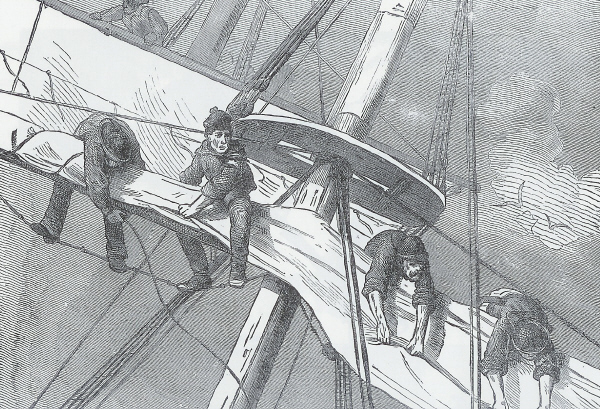
Aloft
furling a sail
(Source: Dover's Natuical Illustrations)
Some who crewed naval vessels did so against their
wishes. A common practice, especially in Britain,
was to fill crews short-handed from illness or
chronic desertion by pressing landsmen into service.
While in port, these men were shackled to prevent
their escape. Seamen, whether pressed or not, found
life aboard ships of the Royal Navy deplorable.
Wages were low. Corruption impacted the quantity and
quality of food served them. Mistakes or infractions
were countered with violent discipline. Poor
ventilation and cramped quarters ensured that
epidemics swept through the crew, killing many.
If such was the life endured by seamen, why did they
risk their lives further by turning pirate? Until
1856 when most countries signed the Declaration
of Paris, governments supplemented their
navies by issuing letters of
marque. With these documents, captains and
their crews “legally” plundered enemy shipping. The
profits realized by such ventures encouraged others
to become privateers.
The problem was that when the war ended, those same
governments had no use for the privateers, who often
found themselves unemployed. Piracy offered them a
choice between starvation, beggary, or thievery and
possible riches beyond their wildest dreams, which
outweighed the threat of execution if caught and a
short life-expectancy rate.
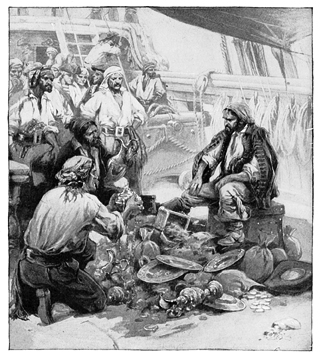 Another aspect to the financial
rewards was that pirates owned a share of the spoils
they captured. Privateers turned over their booty to
the governments that licensed them. Although they
received a share after the goods were sold, that
money was either a long time in coming or a paltry
amount when compared to the risk taken. Treasure –
Latin American gold, Bolivian silver, and Asian
silks, spices, and gold – lured many to turn pirate. Another aspect to the financial
rewards was that pirates owned a share of the spoils
they captured. Privateers turned over their booty to
the governments that licensed them. Although they
received a share after the goods were sold, that
money was either a long time in coming or a paltry
amount when compared to the risk taken. Treasure –
Latin American gold, Bolivian silver, and Asian
silks, spices, and gold – lured many to turn pirate.
Some saw piracy as a means of escaping the grueling
work and terrible conditions that seamen endured. In
addition to the filth, cramped quarters, and
insufficient or spoiled food and fresh water,
dampness permeated their lives. Each new port
exposed them to new diseases that often swept
through the crew because they ate, slept, and worked
in close quarters. Disease
– including scurvy, dysentery, tuberculosis, typhus,
and smallpox – killed half of all seamen.
Other men wished to escape the cruelties inflicted
on them for minor and major infractions. Piracy
promised them a better way of life, the chance to
make their fortunes, and the opportunity to leave
the drudgery of life on land. As pirates, all men
were equal. No longer did one man outrank another.
The crews chose their captains, and signed articles of
agreement to ensure that everyone earned a
share of any prize taken. Such freedom was
unavailable to men who remained on the right side of
the law.
In some parts of the world, people became pirates
out of economic
necessity. Fishing and boating were their
means of livelihood. If the fishing dried up, they
needed to find another way to earn enough money to
live, and so resorted to smuggling and/or piracy.
This has been true for centuries along the southeast
coast of China. It also happened to the buccaneers
and privateers who worked in the logwood
industry of Honduras. After the Peace of Utrecht,
the Spaniards destroyed their livelihood, leaving
them to starve or join one of the pirate crews that
sailed the Caribbean.
For many centuries, Europe was plagued by wars
interspersed with times of peace. When at war,
nations recruited men to serve in their navies. When
peace came, these same men were forced to find other
employment or die of starvation. Those who knew only
the trade of sailing often turned to piracy. Such
was the case following the War of the
Spanish Succession. Prior to the cessation of
hostilities, the Royal Navy employed 53,000 men.
With peace at hand, they dismissed 40,000 of those
seamen. At about this same time (1715-1725), there
was an upsurge in piracy along coasts bordering the
Atlantic Ocean. Most English-speaking pirates came
from the Royal Navy, merchant ships, and privateers.
Between 1716 and 1718, there were 1,800 to 2,400
pirates. By 1726, those numbers dropped to 1,000 to
1,500 pirates.
That’s not to say all men who turned to piracy did
so willingly. When pirates captured a ship, they
either killed those lacking seamanship skills
or put them ashore. Able-bodied seamen, especially
those who possessed a specialized skill (surgeons,
carpenters, coopers, musicians) had no such option.
Pirate crews always needed men familiar with ships
and the sea, and so forced them to join in their
nefarious trade. During the golden age
of piracy, many pirates who sailed in
Caribbean waters were forced men.
Whether willing or not, pirates hailed from many
nations. While most were illiterate and came from
poor families, some – like Stede
Bonnet and Doctor John
Hincher – were educated gentlemen. During the
seventeenth and eighteenth centuries, the average
pirate prowling the Caribbean was in his twenties.
Few pirates plied their trade for more than ten
years. The more famous, like Blackbeard and Captain
Kidd, were pirates for no more than two or three
years. Only a small number lived long enough to
enjoy their ill-gotten wealth.
Review
Copyright ©2001 Cindy Vallar

Click to contact me
Background image compliments
of Anke's Graphics |



